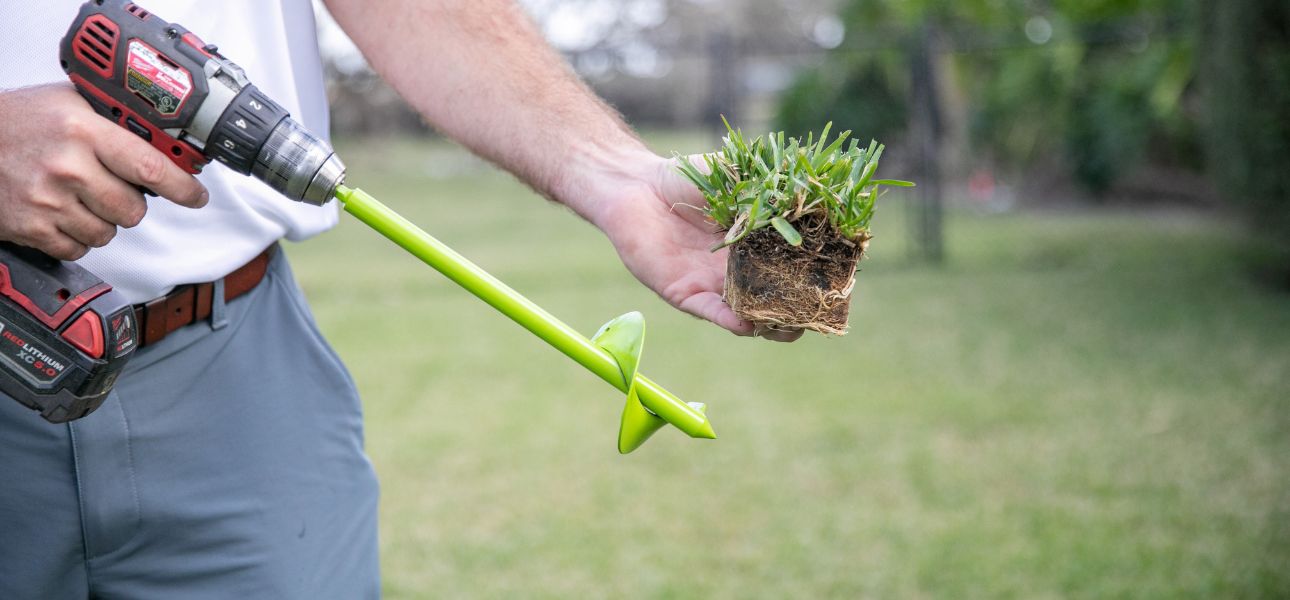Homeowner's Guide to Aerating a Lawn

Routine lawn maintenance practices such as mowing, watering, and fertilizing are key to a healthy, dense lawn. However, annual measures like aerating are equally important as they can amplify these efforts.
Aerating your lawn helps with drainage, soil compaction, and nutrient absorption, encouraging healthy grass growth. When timed and performed correctly, using plug aerators to aerate your lawn can complement your regular efforts to get the most out of your grass.
What is Aeration?
Grass requires air, water, and nutrients to grow thick, deep, and resilient against pests and diseases. However, when soil becomes compacted, it prevents these essentials from penetrating deep into the soil and reaching the roots, resulting in nutrient deficiencies. When deprived of nutrients, your grass may struggle to maintain its color, develop healthy roots, and survive in stressful conditions such as heat and drought.
Aeration solves these issues by perforating the soil and allowing air, water, and nutrients to access the grass roots. This process contributes to healthier root development and a stronger lawn, particularly when planting grass plugs.

Should You Aerate Your Lawn?
The primary reason to aerate your lawn is to alleviate compacted soil, which naturally happens as your soil settles over time. Below are some signs your lawn may benefit from aeration:
Heavy Foot Traffic: Foot traffic can lead to compacted soil, particularly in high-traffic areas, preventing root growth and nutrient uptake in your lawn.
Excessive Thatch Buildup: A soil surface that dries out easily and has a spongy feel may signal an excessive thatch buildup—a layer of dead grass and organic matter. When this layer exceeds half an inch, aeration is usually advised. However, keep in mind that while aeration can help, dethatching is a separate process.
Poor Drainage: Puddles or standing water after rainfall also often signal compacted soil—a problem aeration can alleviate by improving water infiltration and drainage.
Sparse Grass Growth: With decreased root growth, compacted soil may also lead to thin or sparse grass growth.
Soil Composition: Heavy clay soil, being denser than sandy soil, is more prone to compaction. Aeration helps enhance soil structure and increase nutrient availability for the roots.
Similarly, aerating your lawn when transplanting grass plugs is essential for nurturing healthy growth. By perforating the soil, it allows for better air, moisture, and nutrient penetration to the roots, creating a conducive environment for growth. This process sets the stage for a resilient lawn by ensuring access to essential resources and long-term success for your new grass.
How to Aerate a Lawn
There are at least two types of aerating tools available: spike and plug aerators. A spike aerator has hollow tines that poke holes into the ground, while a plug aerator removes soil plugs. However, you'll find that removing soil plugs is more effective in relieving soil compaction than poking holes, which may even inadvertently cause further compaction.
For best results, we recommend using the SodPods grass plug tool. It attaches to most cordless drills for added convenience, saving you from renting machines from lawn and garden stores. Whether using a plug or spike aerator, aerating starts with mowing and watering your lawn.

Mow Your Lawn
Prior to aerating your lawn, run the lawn mower over your turf to have better access to the ground. Adhere to the one-third rule, cutting no more than a third of the grass length each time to prevent scalping. Additionally, set the mower blades at the proper height—at least 1-2 inches above the ground—to avoid cutting too close.
Then, clear the lawn by removing grass clippings and debris like fallen leaves and sticks to remove any obstruction as you aerate your lawn.
Water Your Lawn
Water your lawn at least a day before aerating. Moist and soft soil is easier to work with, making it easier for the grass plugger to extract soil plugs than when the soil is dry.
Aerate Your Lawn
Whether you're using a spike or plugger, start by making multiple passes across your lawn, paying particular attention to the most compacted areas. When using a plugger, aim to extract plugs approximately 2-3 inches apart.
Once the plugs are removed, allow them to dry out before breaking them up by running them over with a lawn mower or pounding them with the back of a rake. This process will ensure a uniform and clean appearance for your lawn.

When Should You Aerate?
The best time to aerate your lawn is during periods of peak grass growth, facilitating faster recovery from the stress of aeration. For warm-season grass, it means aerating in late spring or early summer, while for cool-season grass, aerating in early spring and fall is most effective. You can also time your aeration ahead of planting grass plugs to maximize its benefits, creating an optimal environment for new grass growth.
However, avoid aerating during winter dormancy or the peak of summer, particularly during drought conditions. Attempting to aerate during these times can harm your grass instead of helping it grow.

Takeaway
While aerating your lawn may seem like an additional chore, its benefits are far-reaching and essential for maintaining a healthy, vibrant lawn. However, to maximize its effectiveness, continuing basic lawn maintenance practices such as fertilizing, mowing, and watering after aerating is crucial. Remember, aerating is just one part of a comprehensive lawn care routine, and by staying consistent with these practices, you'll ensure a lush, resilient lawn year-round.
For a selection of sod grass for sale to start a new lawn or repair an existing one, visit the SodPods website today.


